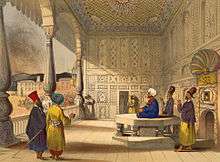Ghurid dynasty
The Ghurids or Ghorids (Persian: سلسله غوریان; self-designation: شنسبانی, Shansabānī) were a dynasty of Iranian descent from the Ghor region of present-day central Afghanistan, but the exact ethnic origin is uncertain.[7] The dynasty converted to Sunni Islam from Buddhism,[5][6] after the conquest of Ghor by the Ghaznavid sultan Mahmud of Ghazni in 1011. The dynasty overthrew the Ghaznavid Empire in 1186 when Sultan Mu'izz ad-Din Muhammad of Ghor conquered the last Ghaznavid capital of Lahore.[8]
Ghurid Sultanate | |||||||||||||||
|---|---|---|---|---|---|---|---|---|---|---|---|---|---|---|---|
| before 879–1215 | |||||||||||||||
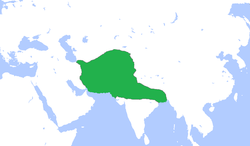 Map of the Ghurid dynasty at its greatest extent under Ghiyath al-Din Muhammad | |||||||||||||||
| Capital | Firozkoh[1] Herat[2] Ghazna (1170s–1215)[3] | ||||||||||||||
| Common languages | Persian (court)[4] | ||||||||||||||
| Religion | before 1011: Buddhism[5] From 1011: Sunni Islam[6] | ||||||||||||||
| Government | Hereditary monarchy | ||||||||||||||
| Malik/Sultan | |||||||||||||||
• 9th-century–10th-century | Amir Suri (first) | ||||||||||||||
• 1214–1215 | Ala al-Din Ali (last) | ||||||||||||||
| History | |||||||||||||||
• Established | before 879 | ||||||||||||||
• Disestablished | 1215 | ||||||||||||||
| |||||||||||||||
At their zenith, the Ghurid empire encompassed Khorasan in the west and reached northern India as far as Bengal in the east.[9] Their first capital was Firozkoh in Mandesh, Ghor, which was later replaced by Herat,[2] and finally Ghazna.[3] The Ghurids were patrons of Persian culture and heritage.[10]
Abu Ali ibn Muhammad (reigned 1011–1035) was the first Muslim king of the Ghurid dynasty to construct mosques and Islamic schools in Ghor.
The Ghurids were succeeded in Khorasan and Persia by the Khwarazmian dynasty, and in northern India by the Mamluk dynasty of the Delhi Sultanate.
Origins
In the 19th century some European scholars, such as Mountstuart Elphinstone, favoured the idea that the Ghurid dynasty relate to today's Pashtun people[11][12][13] but this is generally rejected by modern scholarship and, as explained by Morgenstierne in the Encyclopaedia of Islam, is for "various reasons very improbable".[14] Instead, the consensus in modern scholarship (incl. Morgenstierne, Bosworth, Dupree, Gibb, Ghirshman, Longworth Dames and others) holds that the dynasty was most likely of Tajik origin.[15][16][17] Bosworth further points out that the actual name of the Ghurid family, Āl-e Šansab (Persianized: Šansabānī), is the Arabic pronunciation of the originally Middle Persian name Wišnasp.[18]
The Ghuristan region remained primarily populated by Buddhists till the 12th century. It was then Islamised and gave rise to the Ghurids.[lower-alpha 1][5]
Language
The Ghurids' native language was apparently different from their court language Persian. Abu'l-Fadl Bayhaqi, the famous historian of the Ghaznavid era, wrote on page 117 in his book Tarikh-i Bayhaqi: "Sultan Mas'ud I of Ghazni left for Ghoristan and sent his learned companion with two people from Ghor as interpreters between this person and the people of that region." However, like the Samanids and Ghaznavids, the Ghurids were great patrons of Persian literature, poetry, and culture, and promoted these in their courts as their own. Contemporary book writers refer to them as the "Persianized Ghurids".[19]
There is nothing to confirm the recent surmise that the inhabitants of Ghor were originally Pashto-speaking, and claims of the existence of Pashto poetry (as in Pata Khazana) from the Ghurid period are unsubstantiated.[20][15]
History
Early history
A certain Ghurid prince named Amir Banji, was the ruler of Ghor and ancestor of the medieval Ghurid rulers. His rule was legitimized by the Abbasid caliph Harun al-Rashid. Before the mid-12th century, the Ghurids had been bound to the Ghaznavids and Seljuks for about 150 years. Beginning in the mid-12th century, Ghor expressed its independence from the Ghaznavid Empire. In 1149 the Ghaznavid ruler Bahram-Shah of Ghazna poisoned a local Ghurid leader, Qutb al-Din Muhammad, who had taken refuge in the city of Ghazna after having a quarrel with his brother Sayf al-Din Suri. In revenge, Sayf marched towards Ghazna and defeated Bahram-Shah. However, one later year, Bahram returned and scored a decisive victory against Sayf, who was shortly captured and crucified at Pul-i Yak Taq. Baha al-Din Sam I, another brother of Sayf, set out to avenge the death of his two brothers, but died of natural causes before he could reach Ghazna. Ala al-Din Husayn, one of the youngest of Sayf's brothers and newly crowned Ghurid king, also set out to avenge the death of his two brothers. He managed to defeat Bahram-Shah, and then had Ghazna sacked and burned and put the city into fire for seven days and seven nights. It earned him the title of Jahānsūz, meaning "the world burner". The Ghaznavids retook the city with Seljuq help, but lost it to Oghuz Turks.
In 1152, Ala al-Din Husayn refused to pay tribute to the Seljuks and instead marched an army from Firozkoh but was defeated and captured at Nab by Sultan Ahmed Sanjar.[22] Ala al-Din Husayn remained a prisoner for two years, until he was released in return for a heavy ransom to the Seljuqs. Meanwhile, a rival of Ala al-Din named Husayn ibn Nasir al-Din Muhammad al-Madini had seized Firozkoh, but was murdered at the right moment when Ala al-Din returned to reclaim his ancestral domain. Ala al-Din spent the rest of his reign in expanding the domains of his kingdom; he managed to conquer Garchistan, Tukharistan, and Bamiyan, and later gave Bamiyan and Tukharistan to Fakhr al-Din Masud, starting the Bamiyan branch of the Ghurids. Ala al-Din died in 1161, and was succeeded by his son Sayf al-Din Muhammad, who shortly died two years later in a battle.
The Ghurids at their zenith
Sayf al-Din Muhammad was succeeded by his cousin Ghiyath al-Din Muhammad, who was the son of Baha al-Din Sam I, and proved himself to be a capable king. Right after Ghiyath's ascension, he, with the aid of his loyal brother Mu'izz al-Din Muhammad, killed a rival Ghurid chief named Abu'l Abbas. Ghiyath then defeated his uncle Fakhr al-Din Masud who claimed the Ghurid throne and had allied with the Seljuq governor of Herat, and Balkh.[23]
In 1173, Mu'izz al-Din Muhammad reconquered the city of Ghazna and assisted his Ghiyath in his contest with Khwarezmid Empire for the lordship of Khorasan. In 1175, Mu'izz al-Din Muhammad captured and annexed the Ghaznavid principality of Punjab in 1186. He was alleged by contemporary historians to exact revenge for his great grandfather Muhammad ibn Suri. After the death of his brother Ghiyath in 1202, he became the successor of his empire and ruled until his assassination in 1206 near Jhelum by Khokhar tribesmen (in modern-day Pakistan).[24]
Decline and fall
A confused struggle then ensued among the remaining Ghūrid leaders, and the Khwarezmids were able to take over the Ghūrids' empire in about 1215. Though the Ghūrids' empire was short-lived, Mu'izz al-Din Muhammad's conquests strengthened the foundations of Muslim rule in India. On his death, the importance of Ghazna and Ghor dissipated, and they were replaced by Delhi as power centre in India during the rule of his Mamluk successors.[25]
Cultural influences
The Ghurids were great patrons of Persian culture and literature and lay the basis for a Persianized state in India.[26][27] However, most of the literature produced during the Ghurid era has been lost. They also transferred Iranian architecture to India.[28]
Out of the Ghurid state grew the Delhi Sultanate which established the Persian language as the official court language of the region – a status it retained until the late Mughal era in the 19th century.
 The two mausoleums of Chisht (the western was built in 1167)
The two mausoleums of Chisht (the western was built in 1167) The eastern mausoleum of Chisht (built in 1194)
The eastern mausoleum of Chisht (built in 1194) The Minaret of Jam in Ghor Province of Afghanistan (finished in 1174/75) – UNESCO World Heritage Site since 2002
The Minaret of Jam in Ghor Province of Afghanistan (finished in 1174/75) – UNESCO World Heritage Site since 2002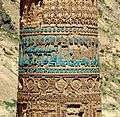 Inscription on the Minaret of Jam, showing the name and titles of Sultan Ghiyath ad-Din Muhammad
Inscription on the Minaret of Jam, showing the name and titles of Sultan Ghiyath ad-Din Muhammad Ornamental bands on the Minaret of Jam, bearing the 19th Sura of the Koran
Ornamental bands on the Minaret of Jam, bearing the 19th Sura of the Koran Ruins of the Shah-i Mashhad madrasa (built in 1176)
Ruins of the Shah-i Mashhad madrasa (built in 1176)
| Titular Name(s) | Personal Name | Reign | |
|---|---|---|---|
| Malik ملک |
Amir Suri امیر سوری |
9th-century – 10th-century | |
| Malik ملک |
Muhammad ibn Suri محمد بن سوری |
10th-century – 1011 | |
| Malik ملک |
Abu Ali ibn Muhammad ابوعلی بن محمد |
1011–1035 | |
| Malik ملک |
Abbas ibn Shith عباس بن شیث |
1035 – 1060 | |
| Malik ملک |
Muhammad ibn Abbas محمد بن عباس |
1060 – 1080 | |
| Malik ملک |
Qutb al-din Hasan قطب الدین حسن |
1080 – 1100 | |
| Abul-Muluk ابولملک |
Izz al-Din Husayn عز الدین حسین |
1100–1146 | |
| Malik ملک |
Sayf al-Din Suri سیف الدین سوری |
1146–1149 | |
| Malik ملک |
Baha al-Din Sam I بهاء الدین سام |
1149 | |
| Malik ملک Sultan al-Muazzam سلطان المعظم |
Ala al-Din Husayn علاء الدین حسین |
1149–1161 | |
| Malik ملک |
Sayf al-Din Muhammad سیف الدین محمد |
1161–1163 | |
| Sultan Abul-Fateh سلطان ابوالفتح |
Ghiyath al-Din Muhammad غیاث الدین محمد |
1163–1202 | |
| Sultan Shahāb-ud-din Muhammad Ghori سلطان شهاب الدین محمد غوری |
Mu'izz al-Din Muhammad معز الدین محمد |
1202–1206 | |
| Sultan سلطان |
Ghiyath al-Din Mahmud غیاث الدین محمود |
1206–1212 | |
| Sultan سلطان |
Baha al-Din Sam III بهاء الدین سام |
1212–1213 | |
| Sultan سلطان |
Ala al-Din Atsiz علاء الدین دراست |
1213–1214 | |
| Sultan سلطان |
Ala al-Din Ali علاء الدین علی |
1214–1215 | |
| Khwarazmian conquest | |||
- Blue shaded rows signifies Ghurid vassalage under the Ghaznavids.
- Yellow shaded rows signifies Ghurid vassalage under the Seljuks.
- Green shaded row signifies Ghurid vassalage under the Khwarazmian dynasty.
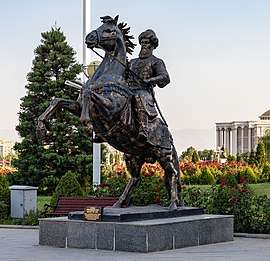 Sultan Ghiyath al-Din Muhammad
Sultan Ghiyath al-Din Muhammad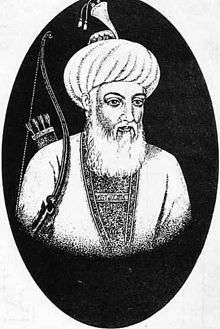 Sultan Mu'izz al-Din Muhammad
Sultan Mu'izz al-Din Muhammad
Bamiyan Branch
| Titular Name(s) | Personal Name | Reign | |
|---|---|---|---|
| Malik ملک |
Fakhr al-Din Masud فخرالدین مسعود |
1152–1163 | |
| Malik ملک |
Shams al-Din Muhammad ibn Masud شمس الدین محمد بن مسعود |
1163–1192 | |
| Malik ملک |
Abbas ibn Muhammad عباس بن محمد |
1192 | |
| Malik ملک Abul-Mu'ayyid ابوالمؤید |
Baha al-Din Sam II بهاء الدین سام |
1192–1206 | |
| Malik ملک |
Jalal al-Din Ali جلال الدین علی |
1206–1215 | |
| Khwarazmian conquest | |||
- Green shaded row signifies Ghurid vassalage under the Khwarazmian dynasty.
Ghurid family tree
| Amir Suri (9th-century-10th-century) | |||||||||||||||||||||||||||||||||||||||||||||||||||||||||||||||||||||||||||||||||||||||||||||||||||||||||||||||||||||||
| Muhammad ibn Suri (10th-century-1011) | |||||||||||||||||||||||||||||||||||||||||||||||||||||||||||||||||||||||||||||||||||||||||||||||||||||||||||||||||||||||
| Abu Ali ibn Muhammad (1011–1035) | Shith ibn Muhammad | ||||||||||||||||||||||||||||||||||||||||||||||||||||||||||||||||||||||||||||||||||||||||||||||||||||||||||||||||||||||
| Abbas ibn Shith (1035–1060) | |||||||||||||||||||||||||||||||||||||||||||||||||||||||||||||||||||||||||||||||||||||||||||||||||||||||||||||||||||||||
| Muhammad ibn Abbas (1060–1080) | |||||||||||||||||||||||||||||||||||||||||||||||||||||||||||||||||||||||||||||||||||||||||||||||||||||||||||||||||||||||
| Qutb al-din Hasan (1080–1100) | |||||||||||||||||||||||||||||||||||||||||||||||||||||||||||||||||||||||||||||||||||||||||||||||||||||||||||||||||||||||
| Izz al-Din Husayn (1100–1146) | |||||||||||||||||||||||||||||||||||||||||||||||||||||||||||||||||||||||||||||||||||||||||||||||||||||||||||||||||||||||
| Sayf al-Din Suri (1146–1149) | Shuja al-Din Muhammad | Qutb al-Din Muhammad | Baha al-Din Sam I (1149) | Nasir al-Din Muhammad Kharnak | Ala al-Din Husayn (1149–1161) | Fakhr al-Din Masud (1152–1163) | |||||||||||||||||||||||||||||||||||||||||||||||||||||||||||||||||||||||||||||||||||||||||||||||||||||||||||||||||
| Ala al-Din Ali (1214–1215) | |||||||||||||||||||||||||||||||||||||||||||||||||||||||||||||||||||||||||||||||||||||||||||||||||||||||||||||||||||||||
| Ghiyath al-Din Muhammad (1163–1202) | Mu'izz al-Din Muhammad (1202–1206) | Shams al-Din Muhammad (1163–1192) | |||||||||||||||||||||||||||||||||||||||||||||||||||||||||||||||||||||||||||||||||||||||||||||||||||||||||||||||||||||
| Sayf al-Din Muhammad (1149–1157) | Ala al-Din Atsiz (1213–1214) | Abbas ibn Muhammad (1192) | Baha al-Din Sam II (1192–1206) | ||||||||||||||||||||||||||||||||||||||||||||||||||||||||||||||||||||||||||||||||||||||||||||||||||||||||||||||||||||
| Ghiyath al-Din Mahmud (1206–1212) | |||||||||||||||||||||||||||||||||||||||||||||||||||||||||||||||||||||||||||||||||||||||||||||||||||||||||||||||||||||||
| Jalal al-Din Ali (1206–1215) | Ala al-Din Muhammad | ||||||||||||||||||||||||||||||||||||||||||||||||||||||||||||||||||||||||||||||||||||||||||||||||||||||||||||||||||||||
| Baha al-Din Sam III (1212–1213) | |||||||||||||||||||||||||||||||||||||||||||||||||||||||||||||||||||||||||||||||||||||||||||||||||||||||||||||||||||||||
Rulers of Ghurid Dynasty
| King | Reign |
|---|---|
| Amir Suri | 9th Century |
| Muhammad ibn Suri | 1007 - 1011 |
| Abu Ali ibn Muhammad | 1011 - 1035 |
| Abbas ibn Shith | 1035 - 1060 |
| Muhammad ibn Abbas | 1060 - 1080 |
| Qutb al-din Hasan | 1080 - 1100 |
| Izz al-Din Husayn | 1100 - 1146 |
| Sayf al-Din Suri | 1146 - 1149 |
| Baha al-Din Sam I | 1149 |
| Ala al-Din Husayn | 1149 - 1161 |
| Sayf al-Din Muhammad | 1161 - 1163 |
| Ghiyath al-Din Muhammad | 1163 - 1203 |
| Mu'izz al-Din Muhammad | 1172 - 1203 |
| 1203 - 1206 | |
| Ghiyath al-Din Mahmud | 1206 - 1212 |
| Baha al-Din Sam III | 1212 - 1213 |
| Ala al-Din Atsiz | 1213 - 1214 |
| Ala al-Din Ali | 1214 - 1215 |
Notes
- The rise to power of the Ghurids at Ghur, a small isolated area located in the mountain vastness between the Ghaznavid empire and the Seljukids, was an unusual and unexpected development. The area was so remote that till the 11th century, it had remained a pagan enclave surrounded by Muslim principalities. It was converted to Islam in the early part of the 12th century after Mahmud raided it, and left teachers to instruct the Ghurids in the precepts of Islam. Even then it is believed that a variety of Mahayana Buddhism persisted in the area till the end of the century[5]
References
- Firoz Koh in Ghur (a region to the west of Ghazni), the Ghurids' summer capital
- Firuzkuh: the summer capital of the Ghurids, by David Thomas, pg. 18.
- The Grove Encyclopedia of Islamic Art & Architecture: Three-volume set, by Jonathan Bloom, Sheila Blair, pg. 108.
- The Development of Persian Culture under the Early Ghaznavids, C.E. Bosworth, Iran, Vol. 6, (1968), 35;;"Like the Ghaznavids whom they supplanted, the Ghurids had their court poets, and these wrote in Persian"
- Satish Chandra, Medieval India:From Sultanat to the Mughals-Delhi Sultanat (1206-1526), Part 1, (Har-Anand Publications, 2006), 22.
- The Ghurids, K.A. Nizami, History of Civilizations of Central Asia, Vol.4, Part 1, ed. M.S. Asimov and C.E. Bosworth, (Motilal Banarsidass Publishers, 1999), 178.
- C. E. Bosworth: GHURIDS. In Encyclopaedia Iranica. 2001 (last updated in 2012). Online edition.
- Kingdoms of South Asia – Afghanistan in Far East Kingdoms: Persia and the East
- Encyclopedia Iranica, Ghurids, Edmund Bosworth, Online Edition 2001, ()
- Finbarr Barry Flood, Objects of Translation: Material Culture and Medieval "Hindu-Muslim" Encounter, (Princeton University Press, 2009), 13.
- Elphinstone, Mountstuart. The History of India. Vol. 1. J. Murray, 1841. Web. 29 Apr. 2010. Link: "...the prevalent and apparently the correct opinion is, that both they and their subjects were Afghans. " & "In the time of Sultan Mahmud it was held, as has been observed, by a prince whom Ferishta calls Mohammed Soory (or Sur) Afghan." p.598-599
- A short history of India: and of the frontier states of Afghanistan, Nipal, and Burma, Wheeler, James Talboys, ( LINK): "The next conqueror after Mahmud who made a name in India, was Muhammad Ghori, the Afghan."
- Balfour, Edward. The Cyclopædia of India and of Eastern and Southern Asia, Commercial Industrial, and Scientific: Products of the Mineral, Vegetable, and Animal Kingdoms, Useful Arts and Manufactures. 3rd ed. Vol. 2. London: Bernard Quaritch, 1885. Web. 29 Apr. 2010. Link: "IZ-ud-DIN Husain, the founder of the Ghori dynaasty, was a native of Afghansitan. The origin of the house of Ghor has, however, been much discussed, – the prevailing opinion being that both they and their subjects were an Afghan race. " p.392
- G. Morgenstierne (1999). "AFGHĀN". Encyclopaedia of Islam (CD-ROM Edition v. 1.0 ed.). Leiden, The Netherlands: Koninklijke Brill NV.
- M. Longworth Dames; G. Morgenstierne; R. Ghirshman (1999). "AFGHĀNISTĀN". Encyclopaedia of Islam (CD-ROM Edition v. 1.0 ed.). Leiden, The Netherlands: Koninklijke Brill NV.
"... there is no evidence for assuming that the inhabitants of Ghūr were originally Pashto-speaking (cf. Dames, in E I1). If we are to believe the Paṭa Khazāna (see below, iii), the legendary Amīr Karōṝ, grandson of Shansab, (8th century) was a Pashto poet, but this for various reasons is very improbable ..."
- Encyclopaedia Iranica, "Ghurids", C.E. Bosworth, (LINK): ". . . The Ghurids came from the Šansabānī family. The name of the eponym Šansab/Šanasb probably derives from the Middle Persian name Wišnasp (Justi, Namenbuch, p. 282). . . . The chiefs of Ḡūr only achieve firm historical mention in the early 5th/11th century with the Ghaznavid raids into their land, when Ḡūr was still a pagan enclave. Nor do we know anything about the ethnic stock of the Ḡūrīs in general and the Šansabānīs in particular; we can only assume that they were eastern Iranian Tajiks. . . . The sultans were generous patrons of the Persian literary traditions of Khorasan, and latterly fulfilled a valuable role as transmitters of this heritage to the newly conquered lands of northern India, laying the foundations for the essentially Persian culture which was to prevail in Muslim India until the 19th century. . . ."
- Encyclopaedia of Islam, "Ghurids", C.E. Bosworth, Online Edition, 2006: "... The Shansabānīs were, like the rest of the Ghūrīs, of eastern Iranian Tājik stock ..."
- Encyclopaedia Iranica, "Ghurids", C.E. Bosworth, (LINK); with reference to Justi, "Namenbuch", p. 282
- Finbarr Barry Flood, Objects of Translation: Material Culture and Medieval "Hindu-Muslim" Encounter, (Princeton University Press, 2009), 13.
- Encyclopaedia of Islam, "Ghurids", C.E. Bosworth, Online Edition, 2006: "... There is nothing to confirm the recent surmise that the Ghūids were Pashto-speaking [...] the Paṭa Khazāna "Treasury of secrets", claims to include Pashto poetry from the Ghūid period, but the significance of this work has not yet been evaluated ..."
- Ghurids, C.E. Bosworth, Encyclopedia of Islam, Vol.2, Ed. Bernard Lewis, C. Pellat and J. Schacht, (E.J.Brill, 1991), 1100.
- The Iranian World, C.E. Bosworth, The Cambridge History of Iran, Vol. 5, ed. J. A. Boyle, John Andrew Boyle, (Cambridge University Press, 1968), 163.
- Balaji Sadasivan, The Dancing Girl: A History of Early India, (ISEAS Publishing, 2011), 147.
- Ira M. Lapidus, A History of Islamic Societies 2nd ed. Cambridge University Press 2002
- Ghurids, C.E.Bosworth, Encyclopaedia Iranica, (15 December 2001);
- Persian Literature in the Safavid Period, Z. Safa, The Cambridge history of Iran: The Timurid and Safavid periods, Vol.6, Ed. Peter Jackson and Laurence Lockhart,(Cambridge University Press, 1986), 951;"...Ghurids and Ghurid mamluks, all of whom established centres in India where poets and writers received ample encouragement.".
- Encyclopedia Iranica, "Delhi Sultanate", Catherine B. Asher,"Although parts of the Indian subcontinent had experienced the impact of Persian culture since the invasion by the Ghaznavid sultan Maḥmūd in the 10th century, Delhi was little affected before 1192, when the Ghurid general Qoṭb-al-Dīn Aybak defeated Prithvi Raj Chauhan, the last Hindu ruler of the city. By 1193 Aybak had taken Delhi itself and had established Islam as the new state religion; the Friday sermon (ḵoṭba) was read in the name of the Ghurid ruler Moʿezz-al-Dīn Moḥammad...[...].. Persian influence on the architecture of the newly established Ghurid splinter state in Delhi was manifest in the very types of buildings constructed, particularly mausolea."
Sources
- C. Edmund, Bosworth (2001). "GHURIDS". Encyclopaedia Iranica, Online Edition. Retrieved 5 January 2014.
- Frye, R.N. (1975). "The Ghaznavids and Ghūrids". In Frye, R.N. (ed.). The Cambridge History of Iran, Volume 5: The Iranian world. Cambridge: Cambridge University Press. pp. 157–165. ISBN 0-521-20093-8.
External links
- Encyclopædia Britannica (Online Edition) – Ghurid Sultanate
- Encyclopædia Britannica (Online Edition) – Muizz-ud-Din-Muhammad a.k.a. Mohammad of Ghor
- Columbia Encyclopedia (Sixth Edition) – Muhammad of Ghor
- The Ghurid Rulers
- The Ghurids
- The Ghurids´ Firuzkuh, the summer capital of the Sultans
